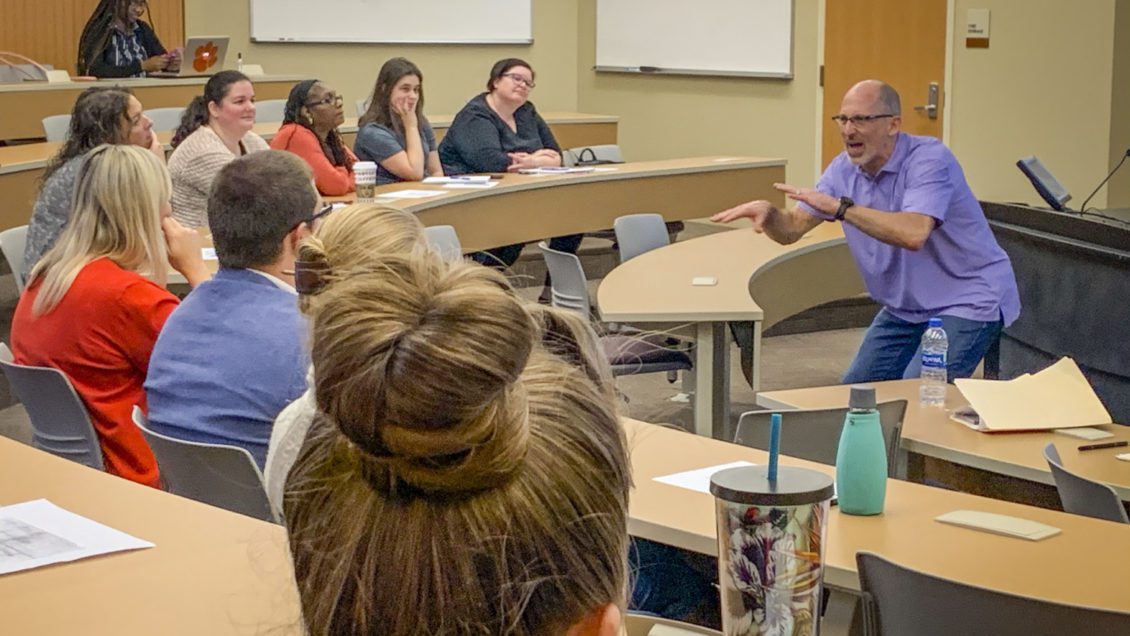Clemson University historian Paul Anderson has a passion for history. When he’s in front of a class his enthusiasm is infectious — with energetic gestures, teasing students about the towns they grew up in or the college they attended, and a liberal sprinkling of self-effacing humor and corny jokes.
It’s a style that served him well recently, as he treated a classroom full of faculty and staff to a thought-provoking workshop titled “Community and History at Clemson,” which took a hard look at some of the difficult truths of Clemson’s past.
The workshop was part of the curriculum for a new Strategic Inclusive Excellence Certificate (SIEC) program designed to help faculty, staff and graduate students develop the skills needed for advancing equity, diversity and inclusion at Clemson. The SIEC program is in turn one part of a long-term plan recommended by a history task force and adopted by Clemson’s Board of Trustees in 2016 intended to develop a comprehensive set of actionable recommendations for how Clemson can better tell the University’s complete history in a way that is “forthcoming, accurate and beneficial.”

Telling Clemson’s complete history starts with the University’s more than 5,300 faculty and staff, said Anderson.
“We’re trying to create a sense of community ownership in the University’s history,” he explained. “What I hope is this will be an ongoing initiative that mirrors the Clemson history course for students. The goal is the same — to convey the history and to get people involved in telling it.”
Participants in the SIEC program can choose from introductory, intermediate and advanced certificates. All three levels require attending three core workshops and three elective workshops, with an added lecture and capstone project required to receive the intermediate and advanced certificates. Those who complete the advanced certificate within two academic years will receive a commendation letter from University President Jim Clements and a plaque at the provost’s academic awards ceremony.
“I think it’s important for us to talk about this history to help move the University forward,” said Moryah Jackson, Clemson’s director of diversity education. “Clemson’s history impacts our campus climate, culture and understanding of one another. The goal of the workshop is to provide an opportunity for faculty, staff and graduate students to reflect on our history and think about how it influences our day-to-day interactions.”

Anderson said that as far as he is aware, Clemson and Washington and Lee University are the only two institutions in the country to hire university historians with the expressed commitment to examine their universities’ history comprehensively. He said coming to terms with its history is unavoidable for Clemson, since the campus itself sits on land taken from Native Americans and turned into a plantation. On becoming a university, its first buildings were constructed using a predominately African American incarcerated workforce as laborers.
“Ours is a unique story, a universally human story, and our campus itself both embraces that entire story and is our primary resource for it,” said Anderson. “So ultimately it’s not only about monuments or buildings or museums, although thinking about those things matters a great deal.”
Anderson does not see the many layers of Clemson’s complicated history as a burden, but as an opportunity.
“We have a rich history here spanning multiple communities of people,” he said. “There are more than 250 archeologically accessible sites on campus. It’s astounding! We have physical things that predate any white settlement here — that’s part of Clemson history too. You can engage the past without being confrontational about it. We have to do this so we shouldn’t be scared of it — we should embrace it and it will embrace us back. I truly believe that.”
When Anderson says “we have to do this” he means it quite literally. During the “Community and History at Clemson” seminar he emphasized that Thomas Green Clemson’s will, which gifted the land and laid out the original plan for the University, only has two fundamental, ongoing requirements and mission statements: That Clemson be a high seminary of learning and the Fort Hill home site be preserved.
“I take the requirement about Fort Hill to be a requirement about history, not just about the house. And I think that’s an honest reading,” he said. “One of our missions is forward-looking, one looks back. I believe that is our directive: Look forward, engage constantly with the past.”
Anderson and Jackson both work closely with students and have seen first-hand how engaged the current student body is in the subjects of diversity, equity and inclusion.
“This is a topic that I think sits on everyone’s mind,” said Jackson. “When you’re talking about diversity and inclusion, you’re thinking about this history. We want to show people that we’re honest about it, we’re talking about it and we’re viewing it through different lenses. It’s important for us to talk about it so more people feel included and welcome at Clemson.”

As the 2016 history task force report states in its opening paragraph: “It’s about understanding, not just knowing.”
By the end of Anderson’s animated three-hour presentation, the collected group of attendees who entered the room mostly as strangers knew each other’s names, hometowns and alma maters. More than a few friendly rivalries had sprung up.
In other words, they were a little more like a family.
That interconnection is at the heart of getting the history right, said Anderson.
“You still love your friends and family — because you’ve worked through struggles and fights together. If we’re talking about something called the Clemson Family — looking honestly at our history is the way to strengthen it, not threaten it or tear it apart.”
The ultimate goal is to make the Clemson story one that past generations, current Tigers and future members of the Clemson community can be proud of for generations to come.
“The past ultimately only contains one thing – change,” said Anderson. “So, this is not about what Clemson was; it’s about what it will be.”

